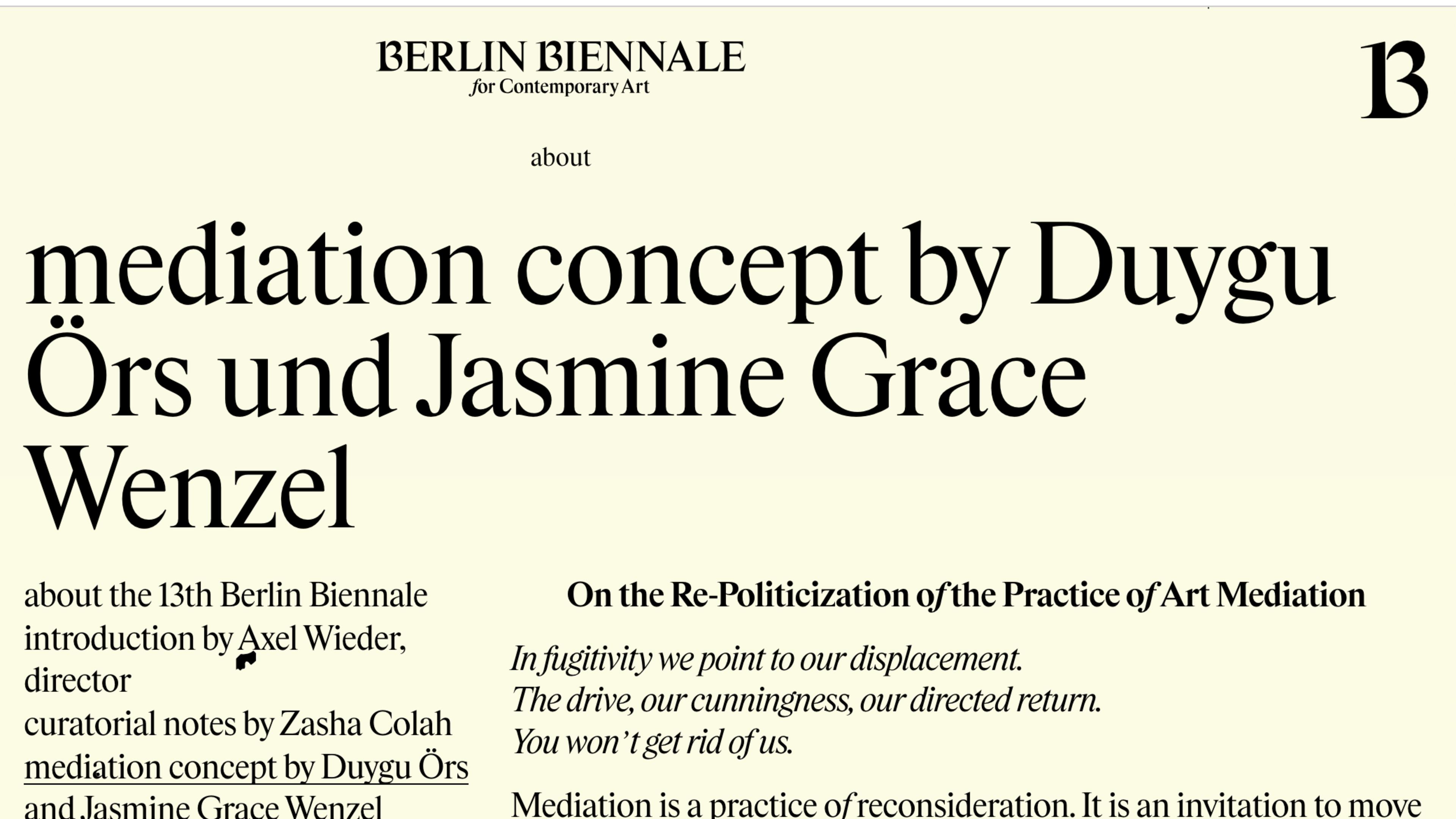People's Tribunal | Berlin Biennale for Contemporary Art Mediation Group
- Talk Show
Loading

On the Re-Politicization of the Practice of Art Mediation
"In fugitivity we point to our displacement. The drive, our cunningness, our directed return. You won’t get rid of us."
Mediation is a practice of reconsideration. It is an invitation to move beyond established strategies, opening up spaces for reorientation, repositioning, and reformulation. At least, this is what it should be.
Thinking and working around mediation is closely related to space, physical as well as social. Art institutions—with their exhibition spaces, communication channels, and discursive spheres—are defined by both their barriers, as well as by their exceptional inclusions. Our experiences of these structures have led us to develop a practice we like to call Vermittlungsverweigerung—a refusal of mediation. We refuse to create exceptions that leave the art machinery untouched—those that fail to slow it down, make it stumble, or force it to rethink its usual ways of operating beyond the limited timeframe of an exhibition.
Instead of focusing solely on institutional barriers, we will shift our attention to how they operate, considering their possibilities as Schleusen [sluices]—mechanisms that make accessible, regulate, and mediate previously inaccessible sections of a channel and thus unknown terrain. In the German context, Schleusen equally refers to the leveling of waterways for ships and to the criminalized practice of escorting a person on the move without papers across national borders.
The mediation program of the 13th Berlin Biennale for Contemporary Art seeks to find methods of expanding existing institutional structures while highlighting material and immaterial resources. The core of this attitude is built on working with selected local actors who are experts in holding communities. We build relationships to the inside of the biennial, adopting code switches that continuously reinterrogate our own standpoints. Beyond outreach, beyond limited invitations to collaborators as guests—but rather, as companions—the direction is not from the institution to the outside, but from the outer spaces inward.
“They didn’t know that the hallway and the stairwell were places of assembly, a clearing inside the tenement, or that you love in doorways.”¹
Mediation projects are curated as an integral part of the exhibition and are treated as artworks in themselves. The intention is to tether the international projects of the 13th Berlin Biennale to the rich cultural-political context of Berlin. The stairwell of the former court on Lehrter Straße is converted into a space of assembly, a tribune to be occupied. We will see adaptations of two People’s Tribunals: one addressing a case on Sudan and another from the Philippines, respectively taking up the repression of activists and civil rights. A People’s Tribunal develops out of necessity—in need of a space for justice when it has been formerly denied. It is a real tribunal,
taking place in exile. The lines between the format, its various adaptations of seeking justice and the claims of the exhibited artists, will be drawn by Moshtari Hilal and Sinthujan Varatharajah in a dedicated room in the former court.
This approach of interweaving different notions and contexts that are present and absent in an exhibition space reappears throughout the mediation program in a variety of ways. Spatial mediation reconsiders social spaces. It always begins with thinking of how we as human beings feel in the exhibition spaces, how we might be supported and feel well in our bodies. As a poet, Tracy Fuad draws upon informal moments like hanging out, resting, and playing—delving into connections between the artistic strategies of the exhibition.
Since public space for dissent and criticism is disappearing, we turn to what can be of use to existing structures. Locally, social safety nets for communal spaces are being dismantled through funding cuts, militarization, and border violence, as well as systemic racism. This affects many public institutions such as cultural institutions, universities, and youth facilities. Our practice centers on pragmatic engagement with what exists, making it usable as a starting point and for forming partnerships.
One of these partners is the artist collective parallelgesellschaft who craft a diverse range of spoken word performances full of laughter and mixed feelings. They hold elaborate discussions on political stances and create communal spaces to deal with these complexities, from a stage in Neukölln to the courtyard of KW Institute for Contemporary Art, beyond already established institutional spaces for literature.
At KW Institute for Contemporary Art, visitors will also encounter the work of Zoncy Heavenly. Her lived experience as an activist, as well as her discursive practice, strongly shape her artistic approach. In her work, she interweaves narratives from Myanmar’s recent history with the immediate responses of artists. Her works offer opportunities to engage with artistic strategies for coping and resilience. By engaging with diverse publics in Berlin and actively involving them, Zoncy Heavenly fosters an interactive experience that deepens understanding of artistic resilience.
The mediation program further comprises university cooperations and dialogical focus-tours on a wide range of topics given by mediators from different knowledge repertoires. These mediators will difficultate the exhibition, allowing expanded modes of experience, a guided encounter in a world that more often than not comes without trigger warnings.
We focus on practices of collective self-mediation, nudging the visitor to think and follow the trajectories of how to use the space, draw connecting lines between different political contexts, and discern patterns of oppression and injustice in order to dismantle their ways of organizing. When art mediation merges with political education, can it provide a social self-defense training for the public?
Duygu Örs, Jasmine Grace Wenzel
¹ Saidiya Hartman, Wayward Lives, Beautiful Experiments (New York, 2019).